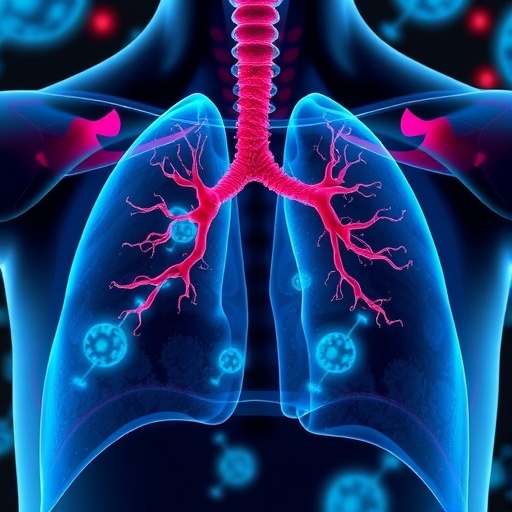In an era where antibiotic resistance poses a stubborn and escalating threat to global health, a groundbreaking study published in Nature Communications offers a beacon of hope. Researchers Zhong, He, Zou, and their colleagues have unveiled an innovative antimicrobial peptide (AMP) that could revolutionize the treatment of bacterial pneumonia — a leading cause of mortality worldwide. This novel therapeutic not only demonstrates potent efficacy against resistant bacterial strains but also curtails the progression of antimicrobial resistance itself, heralding a paradigm shift in infectious disease management.
Bacterial pneumonia, primarily caused by pathogens such as Streptococcus pneumoniae and Klebsiella pneumoniae, remains a formidable challenge for clinicians due to the rapid emergence of drug-resistant strains. Traditional antibiotics struggle to keep pace with evolving resistance mechanisms, leading to prolonged hospitalizations, increased healthcare burdens, and higher mortality rates. Against this backdrop, AMPs have emerged as promising candidates due to their unique mechanisms targeting bacterial membranes and immune modulation, which differ fundamentally from classical antibiotics.
Zhong and colleagues embarked on an extensive investigation to characterize a synthetic antimicrobial peptide designed to combat bacterial pneumonia effectively. Their AMP was engineered with a dual strategy in mind: not just killing bacteria efficiently, but also modulating host immune responses to reduce inflammatory damage, a hallmark of severe pneumonia. Their work combined in vitro assays, in vivo infection models, and advanced molecular profiling to elucidate the multiple facets of this peptide’s functionality.
The peptide’s mode of action was meticulously analyzed. Unlike conventional antibiotics that typically inhibit essential bacterial enzymes or protein synthesis, this AMP exhibited potent membrane-disruptive activity. It selectively interacted with negatively charged components of bacterial membranes, causing rapid permeabilization and bacterial death. This biophysical attack mechanism leaves little room for bacteria to develop resistance, as it targets fundamental structural elements rather than mutable biochemical pathways.
In experimental pneumonia models utilizing resistant bacterial isolates, administration of the peptide led to significant reductions in lung bacterial loads. Remarkably, treated animals displayed improved survival rates and attenuated lung pathology compared to controls treated with conventional antibiotics. Histopathological examinations revealed diminished neutrophil infiltration and lower levels of cytokines implicated in inflammatory injury, underscoring the peptide’s immunomodulatory capacity.
Crucially, the study highlighted the peptide’s ability to suppress the emergence of resistance during prolonged therapeutic exposure. Serial passage experiments demonstrated that bacteria exposed to the peptide over multiple generations failed to develop significant resistance traits. Molecular analyses revealed no mutations in key membrane components targeted by the peptide, suggesting a robust and sustainable antimicrobial profile.
Beyond its direct antibacterial effects, the peptide also appeared to engage host signaling pathways that promote clearance of infection and resolution of inflammation. Transcriptomic analyses of lung tissues from treated animals showed upregulation of genes involved in phagocytosis and tissue repair while downregulating pro-inflammatory mediators like TNF-α and IL-6. This dual functionality positions the peptide as a novel therapeutic that not only eradicates pathogens but also orchestrates a balanced immune response.
From a translational perspective, the AMP exhibited minimal cytotoxicity to mammalian cells in vitro and lacked observable adverse effects in vivo at therapeutic doses. Its stability in biological fluids and amenability to synthetic modification further enhance its viability as a clinical candidate. These pharmacological attributes suggest that the peptide could be developed into inhaled formulations, ensuring direct delivery to the lungs and reducing systemic exposure.
Importantly, this research addresses one of the most pressing medical dilemmas: how to manage bacterial infections effectively without fueling the antibiotic resistance crisis. By leveraging a mechanism that bacteria struggle to evade, the peptide represents a departure from the classical antibiotic paradigm. This advance could enable clinicians to treat severe bacterial pneumonia with agents that remain effective over long periods, thereby preserving the therapeutic arsenal against multidrug-resistant pathogens.
The implications of this study extend beyond bacterial pneumonia alone. AMPs with similar design principles could be tailored to target a range of infections, including those caused by biofilm-forming and intracellular bacteria, which are notoriously refractory to treatment. Additionally, peptides capable of modulating host immunity without causing excessive inflammation could find applications in chronic infections and inflammatory lung diseases.
This work exemplifies a strategic fusion of molecular design, microbial pathogenesis understanding, and immunological insight. The multidisciplinary approach adopted by Zhong and team is indicative of the future of antimicrobial drug development, emphasizing combinations of direct pathogen targeting with host-directed therapy to maximize efficacy while minimizing collateral damage.
Moreover, the study underscores the critical importance of continuous innovation in antimicrobial therapeutics amid the global threat of antibiotic resistance. With diminishing returns from traditional small-molecule antibiotic discovery pipelines, alternate modalities such as AMPs, phage therapy, and immunomodulators are gaining momentum. Still, rigorous clinical development and safety profiling remain pivotal before such candidates can be broadly adopted.
In sum, this pioneering antimicrobial peptide offers a compelling glimpse into the next generation of pneumonia therapeutics. It holds the promise not only of effective bacterial clearance but also of mitigating the deleterious inflammatory sequelae that often exacerbate disease severity. By circumventing conventional resistance mechanisms and engaging host defenses synergistically, this strategy could transform the clinical landscape for patients afflicted by resistant pulmonary infections.
As antimicrobial resistance continues its relentless advance, innovations like this peptide represent a critical frontline defense. Further clinical trials and optimization efforts will determine the ultimate translational success of this promising agent. Nonetheless, the insights garnered here invigorate the quest for sustainable solutions to some of modern medicine’s most daunting infectious challenges.
Looking ahead, collaborative efforts integrating peptide chemistry, microbiology, immunology, and pharmacology will be essential to refine and deploy such therapeutics effectively. The convergence of these disciplines heralds an exciting epoch in infectious disease treatment — one where smartly engineered peptides reinvigorate our ability to combat stubborn bacterial adversaries and restore hope against resistance.
Subject of Research: Antimicrobial peptides as therapeutic agents targeting drug-resistant bacterial pneumonia.
Article Title: An antimicrobial peptide as a potential therapy for bacterial pneumonia that alleviates antimicrobial resistance.
Article References:
Zhong, C., He, Y., Zou, J. et al. An antimicrobial peptide as a potential therapy for bacterial pneumonia that alleviates antimicrobial resistance. Nat Commun 16, 10488 (2025). https://doi.org/10.1038/s41467-025-65449-w
Image Credits: AI Generated
DOI: https://doi.org/10.1038/s41467-025-65449-w
Tags: antibiotic resistance solutionsantimicrobial peptides for pneumonia treatmentbacterial pneumonia challengescombatting drug-resistant bacteriaglobal health and pneumoniaimmune modulation in infectionsinnovative antimicrobial therapiesKlebsiella pneumoniae resistance issuesNature Communications antimicrobial researchnovel therapeutic strategies for infectionsStreptococcus pneumoniae treatment optionssynthetic peptides against bacteria





